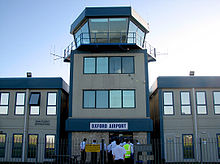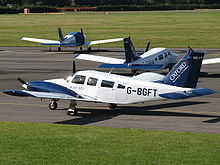- Oxford Aviation Academy
-
Oxford Aviation Academy 
Motto "Skills For Flight" Established 1961 Location Oxford, England, UK Website http://www.OAA.com/ Oxford Aviation Academy is an aviation training organisation. It includes the former Oxford Aviation Training - a commercial pilot training school based at Oxford Airport in the United Kingdom and Phoenix Goodyear Airport in the United States; the former SAS Flight Academy, the former GECAT and the former BAE Systems Woodford, UK Training Centre, all of which are majority owned by STAR Capital Partners of London with a minority stake of less than 20% retained by GE Commercial Aviation Services.
The "Airline Preparation Programme First Officer" course is a full time, Integrated Joint Aviation Authorities/European Aviation Safety Agency (JAA/EASA) course leading to the award of a 'frozen' (becoming unfrozen when the candidate has completed 1500 hours in a multi-pilot environment) Airline Transport Pilot License (ATPL).
Contents
Oxford Aviation Academy history
 The air traffic control tower at Oxford Airport.
The air traffic control tower at Oxford Airport.
Oxford Aviation Academy is one of the world's leading flight training organisations and has been training high calibre pilots throughout its vast history.
Oxford Flying Club was officially opened by the Mayor of Oxford in 1939. However, restrictions placed on civil aviation during World War II curtailed its activities and the airfield operated as RAF Kidlington for the duration of hostilities. The club reopened in 1947, renamed as the Oxford Aeroplane Club. During the 1950s it gradually increased its fleet and, by 1960, had become a flying school geared to the training of professional pilots.
In 1961, the flying school's parent company, Oxford Aviation, merged with the Pressed Steel Company to become British Executive Air Services Ltd. (BEAS). Dedicated ground school buildings and student residential accommodation were provided on site, and the first fully integrated Commercial Pilot's Licence (CPL) and instrument rating (IR) courses began in May 1962.
In 1963, the BEAS Flying Training Division was renamed Oxford Air Training School. Since then, over twenty thousand trained commercial pilots and aircraft engineers have graduated from the school. The school changed its name to Oxford Aviation Training (OAT) in the 1990s.
On 19 June 2007, OAT's parent company BBA Aviation sold OAT to GCAT Flight Academy (formerly General Electric Commercial Aviation Training, part of General Electric and SAS Flight Academy, part of Scandinavian Airlines System) for $63 million (£32 million). The deal was backed by GCAT Flight Academy's majority shareholder, STAR Capital Partners an independent venture capital fund.
On 1 February 2008, OAT was re-branded as Oxford Aviation Academy (OAA). The new Oxford Aviation Academy website was launched on 4 February 2008.[1]
In 2008 OAA acquired General Flying Services, based in Moorabbin, VIC, Australia.[2]
APP First Officer
The flagship course of OAA is the full time ab-inito 'Airline Preparation Programme' (APP First Officer).
It is a JAA approved full time course and is used to train pilots to the level of proficiency necessary to enable them to operate on a multi crew aircraft in the position of a first officer, within a commercial airline. The course is designed for trainees who have little or no previous flying experience. The academy has strong connections with many of the worlds leading airlines having built up a reputation for providing high quality pilots to airlines through cadet schemes. Since 9/11, these "sponsored" programmes are very rare and most trainee's are now "self-sponsored," and can seek employment with any airline (using the JAA license) upon graduation.
After a rigorous pre-selection process, successful candidates are offered a place on the Airline Preparation Programme, subject to Class 1 JAA medical requirements. The initial theory and 14 JAA/EASA ATPL exams as well as the Instrument Rating and Multi Crew Co-operation/Jet Operations Course (MCC/JOC) are completed at OAAs Oxford Training Centre (located at Oxford Airport) while the Commercial Pilot's License is gained at OAA's training facility at Phoenix Goodyear Airport.
Course Structure
Assessment
To gain a place on the course it's necessary to complete a two day assessment at OAA's Oxford training centre. The assessment is designed to test candidates':
- Aptitude
- Capacity
- Technical Knowledge
- Personality
- Team Skills
- Verbal Reasoning
- Communication Skills
- Commitment
If successful in completing the assessment to the necessary standard then applicants are welcomed to join the APP course, with new courses starting approximately once a month.
Ground School
The first six months of the course are all completed in Oxford and it is during this time that students work to complete the 14 JAA/EASA ATPL theoretical exams. Completion of these exams is a pre-requisite to travelling to Phoenix to complete the practical flying and taking of the CPL Skills Test.
The 14 ATPL exams are as follows:
- Principles of Flight
- Aircraft General Knowledge – Systems
- Aircraft General Knowledge - Instrumentation
- Human Performance
- Meteorology
- VFR Communications
- IFR Communications
- General Navigation
- Radio Navigation
- Flight Planning
- Aircraft Performance
- Mass & Balance
- Operational Procedures
- Air Law
At the end of the six months students will have completed 760 hours of ground school. The average grade for students on an APP course is 94%.
Initial Flight Training
The next five months of the course are spent in Phoenix, U.S.A. which allows students to take advantage of the good weather and get used to very busy General Aviation airspace. The first 110 hours of flying are completed on the PA-28 Warrior, a single piston engine aircraft. 10 hours of flying are then completed in the PA-34 Seneca, a multi engine aircraft which is used for the CPL Skills Test. When successful then students return from Phoenix with a Multi Engine Commercial Pilot Licence.
Advanced Flight Training
The Advanced Flight Training takes place back in Oxford and students will complete 30 hours time in a Flight and Navigation Procedures Trainers (FNPT) II fixed base simulator and 20 hours flight time in the PA-34 Seneca. This flying is designed to teach students to use aircraft instruments for navigation and culminates in the Instrument Rating Skills Test (IRT).
Multi Crew Co-Operation and Jet Operations Course
The final phase of training takes place over three weeks using a six axis full motion Boeing 737-400 simulator at Oxford. 20 hours are dedicated to the MCC which teaches students how to work effectively in a multi crew environment. The final 16 hours focus on the JOC allows students to get used to operating a modern jet airliner.
In summary the integrated course consists of 216 hours of flight training and 760 hours of ATPL theoretical knowledge training and lasts approximately 18 months – culminating in the issue of a JAA CPL with Instrument Rating and Multi Crew Co-Operation credit. Following this course, a pilot is now qualified to gain employment in any airline within the JAA licensing region as a First Officer.
Fleet
An OAA Piper PA-34 Seneca at Oxford Airport
Aircraft Fleet Location Piper PA-28 Warrior 28 Phoenix Piper PA-34 Seneca 22 Phoenix & Oxford Socata TB-20 Trinidad 2 Oxford Cessna 172s 13 Melbourne Simulator Location Airbus A320 London, Stockholm & Hong Kong Airbus A330/A340 London, Stockholm & Hong Kong BAe ATP Manchester BAe 146 Manchester BAe Jetstream 32 Manchester Bell 212/412 Stockholm Boeing 737-300/400/500 Oxford, London, Riga, Stockholm, Oslo Boeing 737 Next Generation London, Stockholm, Oslo, Copenhagen, Hong Kong Boeing 747 Buenos Aires, London Boeing 757/767 London, Stockholm McDonnell Douglas MD-80 Stockholm, Copenhagen McDonnell Douglas DC-10 London Bombardier CRJ200 Oxford Bombardier Dash 8-200/300/400 Stockholm, Oslo Embraer 170 London Fokker F28 Stockholm Fokker 50 Stockholm Hawker 700 London Piper PA-28 Warrior Oxford & Phoenix Piper PA-34 Seneca Oxford & Phoenix Saab 340 Stockholm Saab 2000 Stockholm See also
References
External links
Categories:- Aviation schools
Wikimedia Foundation. 2010.

